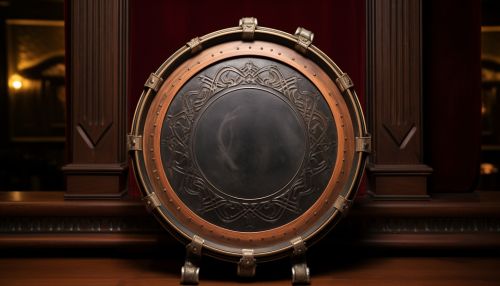Tympanum (Musical Instrument)
Introduction
The tympanum is a musical instrument that has been used throughout history in various cultures and musical genres. It is a type of percussion instrument, specifically a drum, that is played by striking the drumhead with a drumstick or mallet. The tympanum is often associated with ancient Greek and Roman music, but it has also been used in other cultures and periods, including in medieval and Renaissance music.


History
The tympanum has a long and varied history, with its use dating back to ancient times. The instrument was used in ancient Greece and Rome, where it was often played in religious ceremonies and public events. The tympanum was also used in the music of the Middle Ages and the Renaissance, and it has continued to be used in various forms in modern music.
Ancient Use
The tympanum was a common instrument in ancient Greece and Rome. It was often used in religious ceremonies, such as the worship of the goddess Cybele in Rome. The instrument was also used in public events and celebrations, such as the Roman games. The tympanum was typically played by women, who would strike the drumhead with their hands or with a mallet.
Medieval and Renaissance Use
In the Middle Ages and the Renaissance, the tympanum was used in both secular and sacred music. It was often used in dance music, where it provided a rhythmic foundation for the melody. The tympanum was also used in the music of the church, where it was played during processions and other liturgical events.
Modern Use
In modern music, the tympanum is used in a variety of genres, including classical, folk, and popular music. The instrument is often used in orchestras, where it is played with a pair of mallets. The tympanum is also used in folk music, where it is often played by hand.
Construction and Design
The tympanum is a type of frame drum, which means that it consists of a drumhead stretched over a circular frame. The frame is typically made of wood, while the drumhead is usually made of animal skin, such as goat or calf skin. The drumhead is stretched tightly over the frame to create a high-pitched sound when struck.
The size of the tympanum can vary, but it is typically around 30 to 40 centimeters in diameter. The instrument is usually played by striking the drumhead with a drumstick or mallet, although it can also be played by hand.
Playing Techniques
There are several techniques for playing the tympanum, depending on the musical context and the desired sound. The instrument can be played with a drumstick or mallet, or it can be played by hand. When played with a mallet, the player can produce a variety of sounds by striking the drumhead in different ways. For example, striking the drumhead in the center produces a deep, resonant sound, while striking it near the edge produces a higher-pitched, more percussive sound.
When played by hand, the player can use a variety of hand techniques to produce different sounds. These techniques include slapping, tapping, and rubbing the drumhead.
Cultural Significance
The tympanum has had a significant cultural impact throughout history. In ancient Greece and Rome, the instrument was associated with religious ceremonies and public events. In the Middle Ages and the Renaissance, the tympanum was used in both secular and sacred music, reflecting its versatility and importance in musical performance.
In modern times, the tympanum continues to be used in a variety of musical genres, demonstrating its enduring appeal and versatility.
